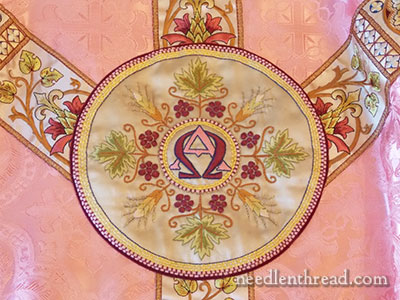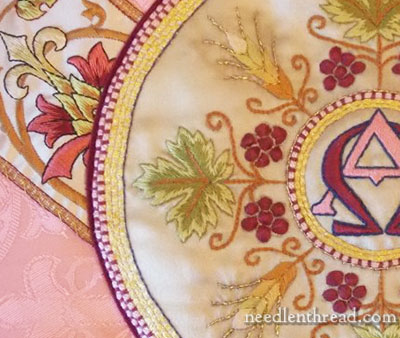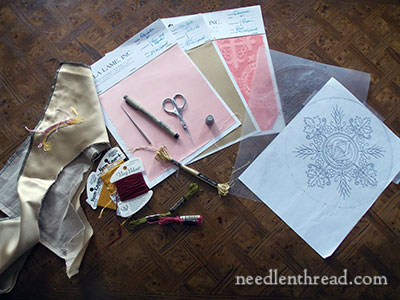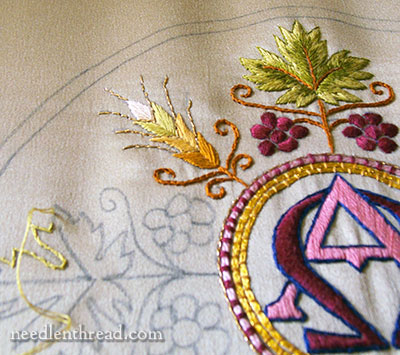Today, I want to share with you a piece of ecclesiastical embroidery worked by Kate – her first piece of ecclesiastical embroidery, as a matter of fact.
I think she did a terrific job on it!

This is the finished embroidery. The medallion is an Alpha & Omega symbol, and the pattern for it can be found in Church Patterns Book One here on Needle ‘n Thread.
The orphreys, or decorative bands that form the cross behind the medallion are sold already embroidered (from LaLame, in NYC).
Kate’s first job in planning out the project was to match the ground fabric and the embroidery on the medallion to the orphreys. This is never an easy task, to match thread and fabric to a pre-existing piece, but I think she definitely pulled it off!

One of my favorite aspects of the piece is Kate’s use of high contrast color on the edge. I really like what she did with the outside edges of the medallion, with the bricking effect on the couching.
The set of vestments is “rose” colored. Today, most rose vestments are actually pink, but the liturgical color “rose” can range anywhere from a light, scarlet-red to a lighter purply-red, to pink.
The color rose is only used twice a year in the liturgy, on the third Sunday in Advent (called Gaudete Sunday) and the fourth Sunday of Lent (called Laetare Sunday), which was this past Sunday. Kate, who also constructed the vestment set, finished them just last week, in good time.

Because it was her first attempt at ecclesiastical work, Kate didn’t want to invest in silk and real gold threads. She also chose the rose vestment because it’s only used twice a year – just in case! But she said for her next piece, she now has the confidence to go for the best supplies for this type of work.
The ground fabric is polyester, the threads are cotton, and the metallics are synthetics, too.

I love the work Kate did on this piece, for a number of reasons:
1. It demonstrates how successful you can be on a project, even if you’ve never tried a particular type of embroidery, by just biting the bullet and trying it!
2. I think Kate did a great job matching sense of the color scheme with the pre-made materials she was working with, and working with the materials she had access to.
3. It’s a an excellent example of how line patterns develop into a finished embroidery project.
4. I think it’s lovely!
Thank you so much, Kate, for sending the photos! I can’t wait to see what you do next, now that you have the confidence to go forward with this type of embroidery!
This time of year, Church Patterns, Book One proves to be a pretty popular item here on Needle ‘n Thread – I’m guessing because it’s Lent, and Easter is right around the corner. Also, in the spring, First Communions, Confirmations, Weddings, and other celebrations are generally on the horizon. There are lots of designs – large and small – in the book that would work well for religious Easter-related projects, first communion, confirmation, and baptismal projects, and even wedding projects, if you’re hankering to do some religious embroidery.







That was a lovely post, Mary. I have long been interested in ecclesiastical embroidery and I have your book, but I have been timid about trying such a project. This may just provide the impetus to start something. Many Thanks!
Thanks for sharing this with us, Mary. Congratulations, Kate. What wonderful work!
This is very timely, as I have been procrastinating about doing something along these lines, but thought I should use silks and goldwork. I was hesitating because I didn’t know if it would be laundered correctly and worried that it would be ruined without the proper care. This gives me confidence to takle it with cottons and synthetics.
Thank you for always providing us with the inspiration to try new things.
Kate did an awesome job! To actually design something that detailed and completing it…kudo’s to her! Maybe I will attempt the alter cloth that’s been rolling around my brain for a while. She gave me a nudge. Thanks
Congratulations, Kate! This is beautiful work. You had me fooled – I thought the embroidery was done in gold and silk threads! Your color sense is right on, and I love those juicy grapes. Thanks for showing us her work, Mary.
-Sharon in France
Dear Kate – Congratutaltions on a lovely piece. I bet it looked lovely last sunday at laetare, you must be very proud. Thanks, Mary, for sharing this. I find it very encouraging for my own early forays into the world of ecclesiastical embroidery!
Wow ~ what an extraordinary job! Kate is an inspiration. I’m been considering Church Patterns – I have a sister-in-law who is a pastor. Where does one find the colors that can be used? I was at a quilting shop for a short shop presentation. A customer showed a stole she had made for a niece who is a pastor. She made a comment about the colors that CAN be used in a stole. I had no idea that there are only certain colors that are acceptable in a stole. I had been considering making a stole for my sister-in-law of the animals in Noah’s arc. I was considering cross stitch since that is my best technique. After she made that comment, I didn’t even attempt such a feat. I didn’t want to invest the time and then find I had done something that wasn’t acceptable. Are the acceptable colors included in the book? Thank you to not only you for this blog but also your readers who contribute with comments and especially those who share their incredible accomplishments.
I think the colour choices in a piece of church garmentry or hangings, etc., depend upon the denomination of the church. Some may be more strict (read that traditional) and some less strict. The pastor at our Methodist church had a variety of pieces she wore, one of which was made of a colourful piece of African fabric she wore over her solid colour robe. Another was embroidered by an artist who did her own thing.
So don’t be scared off by what one person told you. Ask at the church itself. God would appreciate the dedication and love that went into the work, no matter the colours.
Some churches, though, subscribe (so to speak) to a “liturgical color code,” so it is always wise to make sure you’re familiar with the liturgical colors, what they mean, and so forth. For example, certain symbols go more correctly with certain colors, because of what both the symbols and the colors mean. In cases where colors for the liturgy are more than a matter of whim, making a mistake on a combination could result in a disaster as far as time and resources are concerned!
So Laura is right! Always smart to ask if you are unsure!
Beautiful ..I love the colours of the ripening wheat .
Breathtakingly beautiful piece of stitching.
Well Done, Kate!
Dear Mary
It must have been daunting to embroider this piece, to match the thread colours and to choose a design I don’t think I would have been so brave, it’s turned out to be a beautiful piece you should be proud of yourself, well done Kate. Thanks for sharing this with us Mary.
Regards Anita Simmance
This Vestment set was requested for the Basilica of St. John in Des Moines IA. Kate really did a wonderful job! Our Pastor is very impressed and is already planning to have additional vestments made.
Thanks Kate and we are very excited to see this beautiful work featured in this web site.
Nice work, Kate! Impressive first piece. I think you have inspired me 🙂
Sarah
Kate – this is very, very beautiful – congratulations on this ambitious accomplishment!
Tomi Jane in MN
Lovely stitching Kate!. In the first photo the colors look muted, in the last they look crisp, what was done? Or is it just the lighting?
Blessings on your next project!
I think it’s the lighting, Sharon – and the angle of the photography.
BEAUTIFUL.
I like it because it proves you can still do beautiful work, even if premium materials are not used.
Just lovely! Thanks for sharing the photos.
Oh, lovely work Kate! Thanks so much for sharing this with us, and being an inspiration.
Kate, What a lovely vestment! Mary, thanks for sharing!
Wow, Kate, amazing work.
Dear Mary, would you happen to know a similar resource for judaica embroidery? Your suggestions always prove very heplful.
Also, I wanted to comment on the secret gaden project for a while now, but only ever read you full posts in my email, so now is the time 😀 What an impressive needlework! You seem to make things, match and blend colours so effortless! Your blog posts are the highlight of my day 🙂
Hi, Kate – I have seen some embroidery books for Jewish items, but mostly, they are cross stitch or needlepoint, or they are simply collections of photos of embroidered items. I’ll keep an eye out and see if I can find those references.
I’m glad you’re enjoying the Secret Garden project. I’ve gotten delayed with stitching this week (thanks to the dentist and taxes!), so this afternoon, I hope to make up some time on it. I should have another installment up by the end of the week. Fingers crossed!
This is beautiful work! I’m so impressed, and it gives me confidence too – a first effort can be all that one wants it to be, with proper planning and careful execution. Thanks Mary, for showing us this, and Kate – you GO!
Kate – beautiful work. Much to be proud of. I look forward to seeing more of your needlework.
Absolutely beautiful piece Kate, congratulations. You should be proud of yourself.
And thanks as always to Mary. I first discovered this site when I was desperately searching for information on Ecclesiastical Embroidery after my mom had volunteered me to repair and replace some of our church linens. I was in a full on panic because I didn’t know if Ecclesiastical Embroidery still existed!
Kate, again, I’m really impressed. I just did linens for communion. I’ve never tried vestments. Very pioneering and brave. Absolutely beautiful work.
Ooooh, it’s gorgeous! I can’t believe it’s your first. You did a perfect job!
Kate, your work is beautiful! Thanks Mary for sharing your reader’s work.
Kate did a beautiful job on this, from her choice of fabric and thread, to her fine stitching. Good luck to her on future projects. Thanks to Kate and Mary for sharing it with us.
Wow!…and I’ll say it again…WOW! Kate you did an awesome job and I sincerely hope you are proud of your work. Just matching the colors and ground fabric must have been a challenge, not to mention tackling a whole new style of embroidery. The wheat and the grape leaves are just gorgeous. The couched borders are beautiful (I haven’t even ventured to *attempt* couching yet). And the satin stitch on the Alpha and Omega are so smooth and even. Congratulations, it’s truly a work of art.
Wow – Go Kate!!!
Kate, What a lovely job you are doing with your embroidery. I would love to be able to be that talented. I’ll be looking forward to seeing it when it is done.
Kate has a beautiful rich style, lovely piece indeed!
Great Job Kate–Thanks for sharing Mary! As to judaica embroidery, there are many needlepoint designs readily available. Friends have stitched painted-canvas yarmulkas, dreidels etc. & they are wonderful family keepsakes. Another friend recently renewed her vows under a wedding chuppah, hand embroidered by the bride’s mother & aunt. A quick Google brought up several resources, including machine embroidery designs. Perhaps another reader will share pictures of judaica embroidery for a future post?
Well! Picks self up from floor. Dusts off self.
Looks again, rolls eyes. Oh wow, oh wow.
Congratulations Kate. And thank you Mary for showing us this inspiring work. I have to confess that my interest in ecclesiastic embroidery is purely from the latter viewpoint as I am not a Christian, but I can and do admire the embroidery very much. This is an excellent piece of work Kate, I can’t wait to see what you produce next time around.
Mary, your explanation of the use of the rose vestments reminded me of my first wedding which was in a Christian church on 30 November. My reading was that that week the colour would change from green to white for Advent, but the priest said it wouldn’t change until the following week so it would be green on our Big Day. To say I was disappointed would be an understatement but OK, them’s the rules. On the day itself, as I walked into the church on my father’s arm the first thing I noticed was not the many people who had come, or the flowers, or anything but the fact that the vestments were …red! Why red? During the service the priest managed to whisper to me that it was St Andrew’s day and on saints’ days the vestments were red. It look superb and thus started my fascination with ecclesiastic vestments and embroideries etc.
Hi, Christina – ah, yes, they would have been red because St. Andrew was a martyr. During Advent, it depends on the saint, really, because every day of the year, technically, has its saint(s), but since St. Andrew was an apostle, and therefore a major saint, his feast is a first class feast, which means it overrides the liturgical season, and since he was a martyr, the vestments would be red. A good example of the meaning of colors with the liturgy!
Just a thought.
It may have been rose originally because red was not really incredibly color fast until recently??
Hmmmm….I’m not sure I understand what you mean, RMW? Maybe I’m misunderstanding it, but here’s a clarification: Rose has only been used liturgically on two days of the year, both of which are Sundays. Symbolically, it’s because of the “lightening up” of the season of Advent and Lent, at the “halfway” points on Gaudete and Laetare Sundays, in which the prayers of the liturgy ring with hope as Christmas or Easter approaches. The first distinction in colors used in the liturgy was in the 4th century AD, and red was among the first colors to be used to distinguish a certain type of feast day (in this case, the feast of a martyr). The use of rose was not introduced until later, so in the order of things, red came first.
That is what I meant, that they started with red, but because red was not colorfast and would pink out after a while, they started using pink to make things easier.
Rose for vestments is a combination of the purple/violet/magenta of Lent or Advent with white of the gestalt season to come.
The embroidery on set of rose vestments was what inspired me to learn Japanese embroidery.
Sounds like Kate’s pastor does appreciate her work. Double congratulations.
Very, very nice. Hope the priest appreciates and takes care of it.